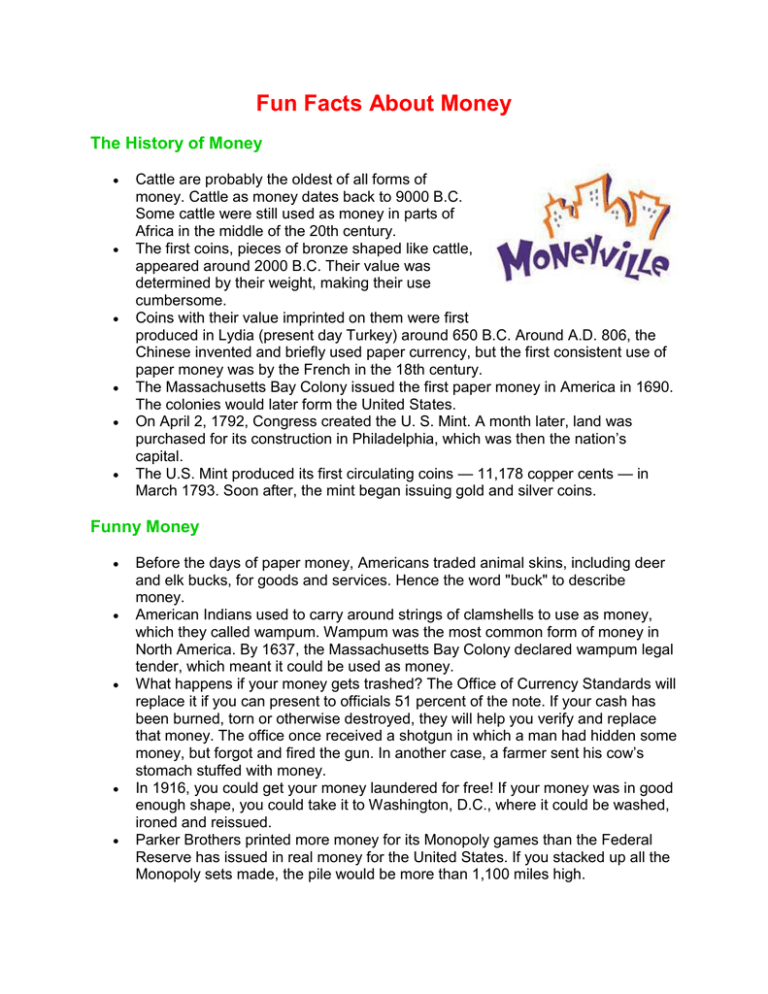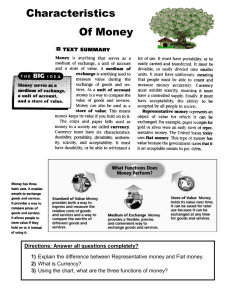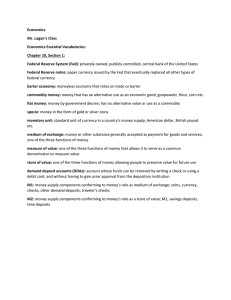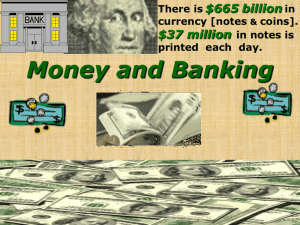Fun Facts About Money
advertisement

Fun Facts About Money The History of Money Cattle are probably the oldest of all forms of money. Cattle as money dates back to 9000 B.C. Some cattle were still used as money in parts of Africa in the middle of the 20th century. The first coins, pieces of bronze shaped like cattle, appeared around 2000 B.C. Their value was determined by their weight, making their use cumbersome. Coins with their value imprinted on them were first produced in Lydia (present day Turkey) around 650 B.C. Around A.D. 806, the Chinese invented and briefly used paper currency, but the first consistent use of paper money was by the French in the 18th century. The Massachusetts Bay Colony issued the first paper money in America in 1690. The colonies would later form the United States. On April 2, 1792, Congress created the U. S. Mint. A month later, land was purchased for its construction in Philadelphia, which was then the nation’s capital. The U.S. Mint produced its first circulating coins — 11,178 copper cents — in March 1793. Soon after, the mint began issuing gold and silver coins. Funny Money Before the days of paper money, Americans traded animal skins, including deer and elk bucks, for goods and services. Hence the word "buck" to describe money. American Indians used to carry around strings of clamshells to use as money, which they called wampum. Wampum was the most common form of money in North America. By 1637, the Massachusetts Bay Colony declared wampum legal tender, which meant it could be used as money. What happens if your money gets trashed? The Office of Currency Standards will replace it if you can present to officials 51 percent of the note. If your cash has been burned, torn or otherwise destroyed, they will help you verify and replace that money. The office once received a shotgun in which a man had hidden some money, but forgot and fired the gun. In another case, a farmer sent his cow’s stomach stuffed with money. In 1916, you could get your money laundered for free! If your money was in good enough shape, you could take it to Washington, D.C., where it could be washed, ironed and reissued. Parker Brothers printed more money for its Monopoly games than the Federal Reserve has issued in real money for the United States. If you stacked up all the Monopoly sets made, the pile would be more than 1,100 miles high. Money is Art! The pyramid you see on the back of your currency is actually the reverse side of the Great Seal of the United States. The pyramid represents strength and permanence and has been left unfinished to signify the future growth of the country. Contrary to popular belief, the automobile pictured on the back of the $10 note is not a Model T Ford. It is a drawing by the person who designed the bill. The vignette on the back of the $100 note is Independence Hall in Philadelphia. There are three people depicted in the engraving. A man and a woman are in front of the hall close to the building; the third person is a man pictured looking toward the building. The hands of the clock on the back of the $100 bill are set at approximately 4:10. Although the time is not readily identifiable to the naked eye, it can be seen when examined with 20-fold magnification. There are no records explaining why that particular time was chosen. During the Civil War, the Bureau of Engraving and Printing was called upon to print paper notes in denominations of 3 cents, 5 cents, 10 cents, 25 cents and 50 cents. The reason for this is that people hoarded coins, which created a drastic shortage. These bills, called greenbacks, were used to pay Civil War soldiers. Martha Washington is the only woman whose portrait has appeared on a U.S. currency note. It appeared on the face of the $1 Silver Certificate of 1886 and 1891, and the back of the $1 Silver Certificate of 1896. There have not been any women featured on U.S. paper currency in the entire 20th century. Amazing Facts If you had 10 billion $1 notes and spent one every second of every day, it would require 317 years for you to go broke. There is about $823 in circulation for each person in America. A piece of currency can be folded forward and back 4,000 times before it will tear. The $100 note has been the largest denomination of currency in circulation since 1969. The largest bill ever printed was the $100,000 bill; it was actually a Gold Certificate issued in 1934. These notes were used for transactions between Federal Reserve banks and were not circulated among the general public. President Woodrow Wilson was depicted on the bill. Making Money Currency is made of 25 percent linen and 75 percent cotton paper. Red and blue synthetic fibers of various lengths are distributed evenly throughout the paper. Prior to World War I, the fibers were made of silk. During fiscal year 1999, it cost the Bureau of Printing and Engraving approximately 4.2 cents per note to produce $11.3 billion U.S. paper currency notes. Ninety-five percent of the notes printed each year are used to replace those already in circulation. Forty-five percent of the notes printed are $1 bills. In 2002, the U.S. Mint produced 14,413,236,610 coins for general circulation. The United States Secret Service was originated in 1865 to combat counterfeit money. At the time, as much as one third of all the money in the United States was estimated to be counterfeit. Currently, about $250,000 in counterfeit money appears each day. One of the ways the Federal Reserve detects counterfeit bills is to check the iron content of the ink. Inflation From 1940 to 1946, the average income in America doubled. During 1940, the average worker was paid less than $600 a year. In 1946 the same worker got $1,200 a year. In 1919 the average income in America was around $650 per year. In the 1920s you could buy a brand new car for less than $300. In 1931 a new Chevrolet cost $623. Between 1968 and 1978 the price of new cars went up drastically. Cars cost twice as much in 1978 as they did in 1968. Shopping was fun in 1900. Women could buy a pair of shoes for just $1! Money Measurements A mile of pennies laid out is $844.80. By this standard, America is about $2.5 million wide, coast to coast. Currency in circulation before 1929 measured 3.125 inches by 7.4218 inches. In 1929, the size was changed to its current measurement of 2.61 inches wide by 6.14 inches long. The approximate weight of a currency note, regardless of denomination is one gram. There are 454 grams in one pound; therefore, it takes 454 notes to make one pound. A million $1 bills weigh 2,200 pounds. A $1 bill is 0.004375-inch thick. If you placed 1 million of them in a neat square, it would measure about four feet tall, four feet wide and four feet thick. A stack of currency one-mile high would contain more than 14 million notes. A stack of bills destroyed in a single year would measure 200 miles high. Mt. Everest, the tallest mountain on Earth, is a mere 19,035 feet, or slightly more than 3 miles high. Fun Facts If you have three quarters, four dimes and four pennies, you have $1.19. You also have the largest amount of money in coins possible without being able to make change for a dollar. Did you know that a quarter has 119 grooves around the edge, and a dime has 118? Do you know the purpose of the ridges on the edges of coins? Without ridges, it is possible to scrape metal off coins without it being obvious. In the days when coins were made of silver or gold, a person could have made a good, but illegal, living from shaving coins and selling the precious metal. During much of the 17th and 18th centuries, the Spanish dollar coin was the unofficial national currency of the American colonies. To make change, the dollar was actually cut into eight pieces or "bits." Thus, came the terms "pieces of eight" from these early times and "two bits" (a quarter) from recent times. The bison on the Buffalo Nickel was from New York City. Named Black Diamond, this bison lived around the turn of the 20th century in the Central Park Zoo. How long do bills last? The Federal Reserve System lists the following life spans: $1 $5 $ 10 $ 20 $ 50 $100 22 months 2 years 3 years 4 years 9 years 9 years Coins usually survive in circulation for about 30 years. Why are U.S. notes green? No one is really sure. However, in 1929, when the Bureau of Printing and Engraving began making smaller size currency, green was continued because pigment of that color was readily available in large quantities. The color was relatively high in its resistance to chemical and physical changes, and green has been psychologically identified with the strong and stable credit of the government. The origin of the dollar sign —$ — has various explanations. Perhaps the most widely accepted is that it is the result of the evolution of the Mexican or Spanish "P’s" for pesos. This theory, derived from a study of old manuscripts, explains that the S gradually came to be written over the P, developing a close equivalent to the $ mark. It was widely used even before the adoption of the United States dollar in 1785.




